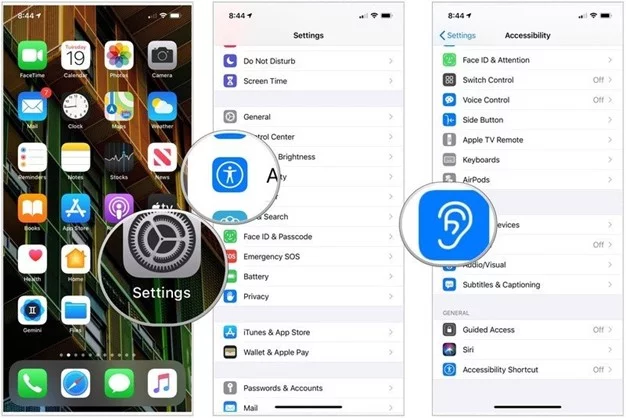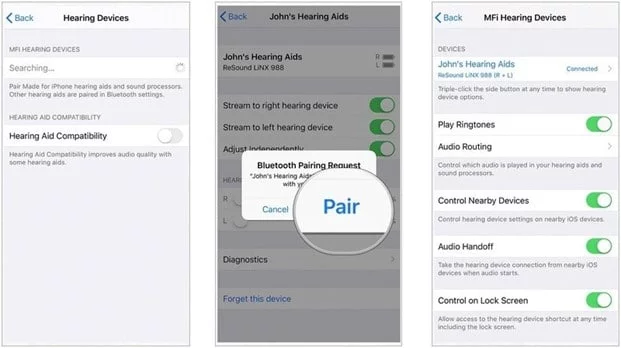
New Hearing Aid Technology is Amazing!
Automatically Adjusting: Although hearing aids have had the ability to automatically change programs since the early 2000’s, it started off as being able to jump between a speech in quiet and a speech in noise setting. Over the past few years, hearing aids are now able to analyze the sound environment that you are in, compare information about it between the left and right devices, and then adapt the settings for that specific environment. This has created much more efficient adjustments while providing a smoother listening experience.
BrainHearing Technology: Oticon More takes hearing healthcare to a new level. It’s the world’s first hearing aid with a Deep Neural Network (DNN) embedded on the chip. The DNN is trained on 12 million real‑life sounds to give your brain more of the information it needs to decipher the intricate details of relevant sounds.
Motion Sensors: One of the latest additions to hearing aids is the addition of motion sensors. This provides the manufacturers with several different options for improving quality of life. Starkey has used this technology in an interesting way, adding step counting as well as fall detection and alerting benefits for their users. Through their app, you can track your steps and activity, much like a Fitbit.
Other manufacturers, such as Signia in their Pure X products, are using this information to better evaluate listening needs. Here is an example of how motion sensors can help an individual hear better. Two hearing aid users are on the side of a busy road. One is sitting on a patio having dinner with their family. The other is walking with their spouse down the street next to the patio. For the first individual, being stationary in a noisy environment, they will likely want the hearing aid to focus on the person across the table from them that they are looking at, and decrease the sounds of the road noise and people walking by. For the person in motion walking, they will want the hearing aid to continue to offer sounds from all directions so they can hear the person beside them and also any other sounds for increased safety.
Music Programs: For a long time, all of the advancements in speech enhancement and sound smoothing that helped the hard of hearing understand speech better made listening to music somewhat of a challenge. In recent years, manufacturers have been working hard to maximize how music sounds as well. One of the things that has helped is that new speakers have more high frequency response, allowing them to amplify more of the sounds in music. The microphone technology is also improving, allowing more of the sound to be captured without distortion. Further to that, manufacturers are creating more programs (inside of the automatically adjusting and outside) to help with the sound quality of music. Widex automatically offer different frequency responses for classical than for contemporary music. Signia has special manual music programs to select for live, recorded or while performing. Each of these offer different parameters to make it sound better for that intended purpose. Phonak can even classify its streamed signals as speech or music, making a significant improvement of the music quality.
Direct Streaming: The vast majority of new hearing aids (other than the smallest options that sit deep in the ear) now offer a direct connection to many of your different devices, such as smartphones and TVs. By connecting your hearing aids directly to these devices, it allows you to hear the sound at exactly the volume that you want while improving speech clarity.
The latest Phonak Paradise hearing aids can connect directly with almost all Android and iPhone smartphones. With these devices connected, you will be notified when a call is coming in by a ringing through the hearing aid. All you need to do is push a button on the device to answer the call and the other person’s voice will come right through the hearing aids. The microphone on your hearing aid will pick up your voice and send it back to the phone. This means there is no need to take the phone out of your pocket or purse when using it. A truly hands free solution!
GPS Tracking: We have been asked for years for a way to help find lost hearing aids. Making use of direct connection to smartphones and the GPS data within the phone, several of the new models of hearing aids can keep track of when the hearing aid was last within range of your cell phone. This location can then be shown on a map, making it much easier to track down a lost device.
3D Printing of custom shells: For any of the custom components of a hearing aid, the manufacturers are now using 3D printing technology to replicate the ear as accurately as possible. Phonak has even started using a 3D printed premium medical-grade titanium material for their smallest device, the Virto Titanium IIC. These titanium shells are only half as thick as a traditional acrylic shell, allowing us to fit all of the electronics into an even smaller space. They also provide 15 times the strength of a traditional material.
Real Time Language Translation: Through the Starkey Thrive App, the Livio Edge AI hearing aids are actually able to listen to someone speaking another language and then translate what they said using Google’s proprietary Google Translate. The hearing aids then have an automated voice that relays the translation into your ears. This is something straight out of a sci-fi movie not too long ago. At this point in time, unless the other person also has these devices themselves, it still isn’t possible to have a two way conversation with both people speaking their own language, but it should certainly make traveling to a foreign country much easier.
Understanding that not all of these features will be relevant for everyone, but there is no denying that the technology that is being built into them is advancing faster than ever and much of it is incredibly cool. We see people in our clinics daily who are excited about how these new technologies are improving their quality of life!
To Learn More about what new technology has to offer you, please call Absolute Hearing Care Centers. We are happy to offer a FREE consultation.
CALL NOW: 843-839-1936



